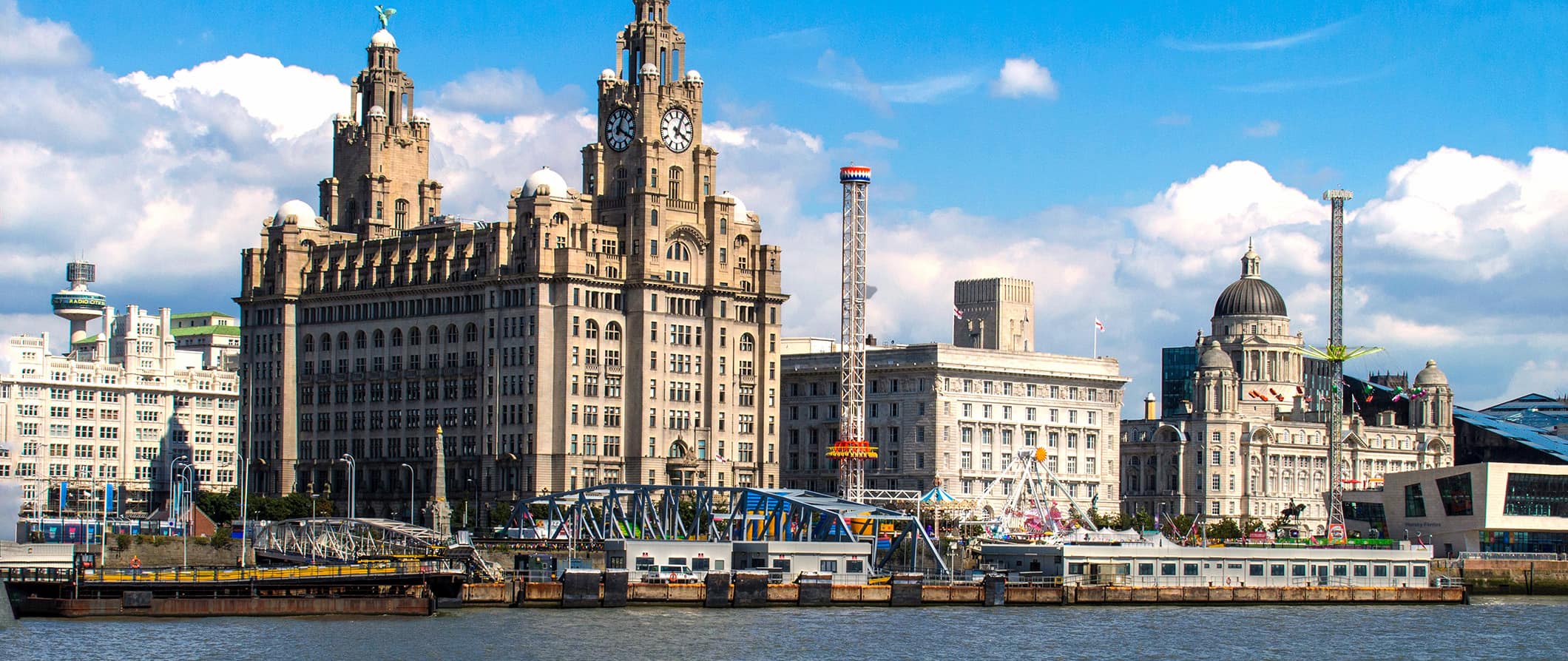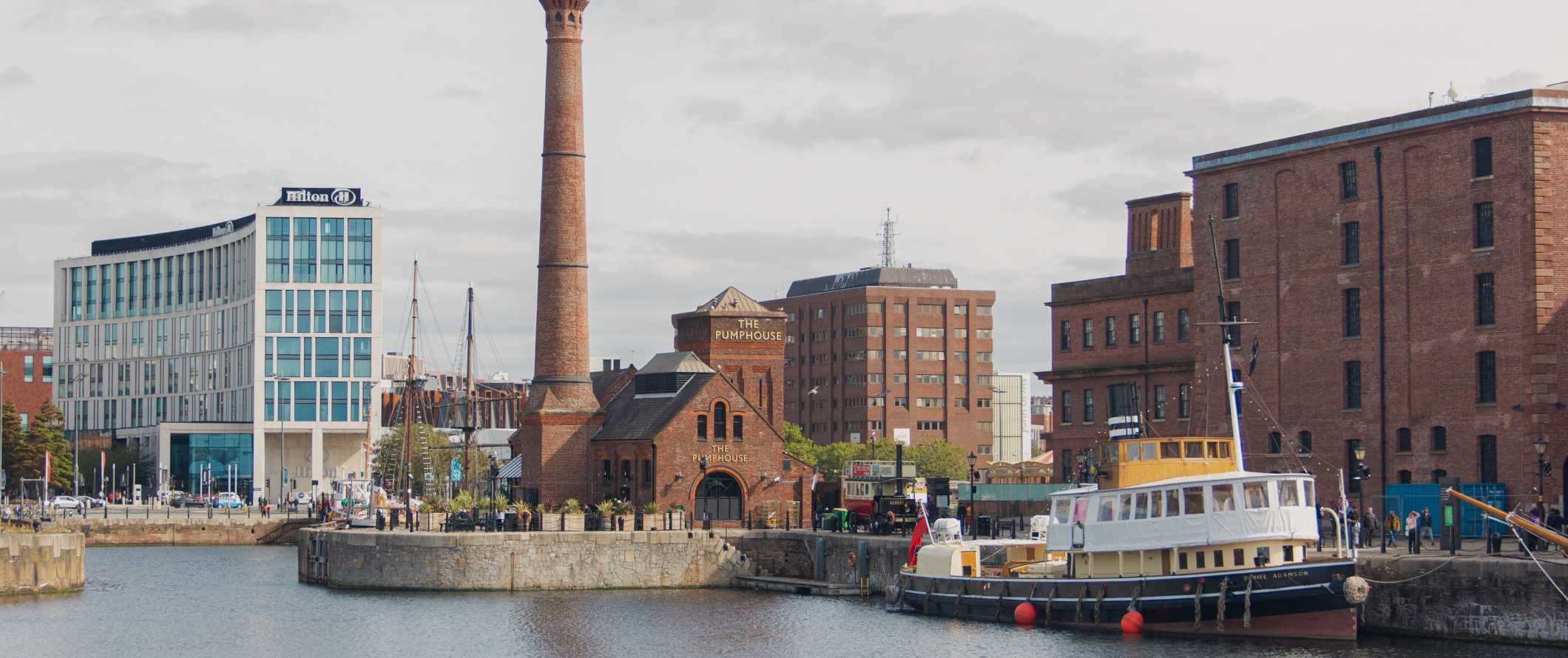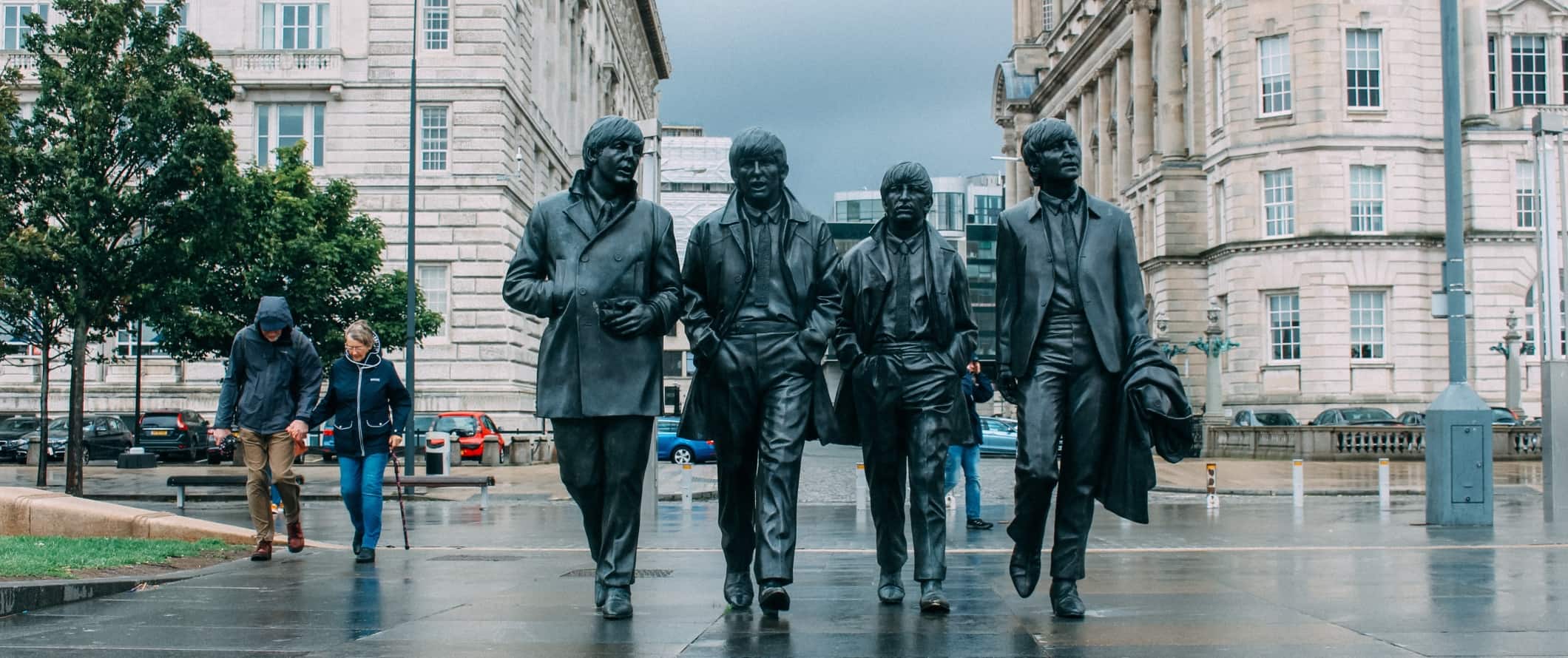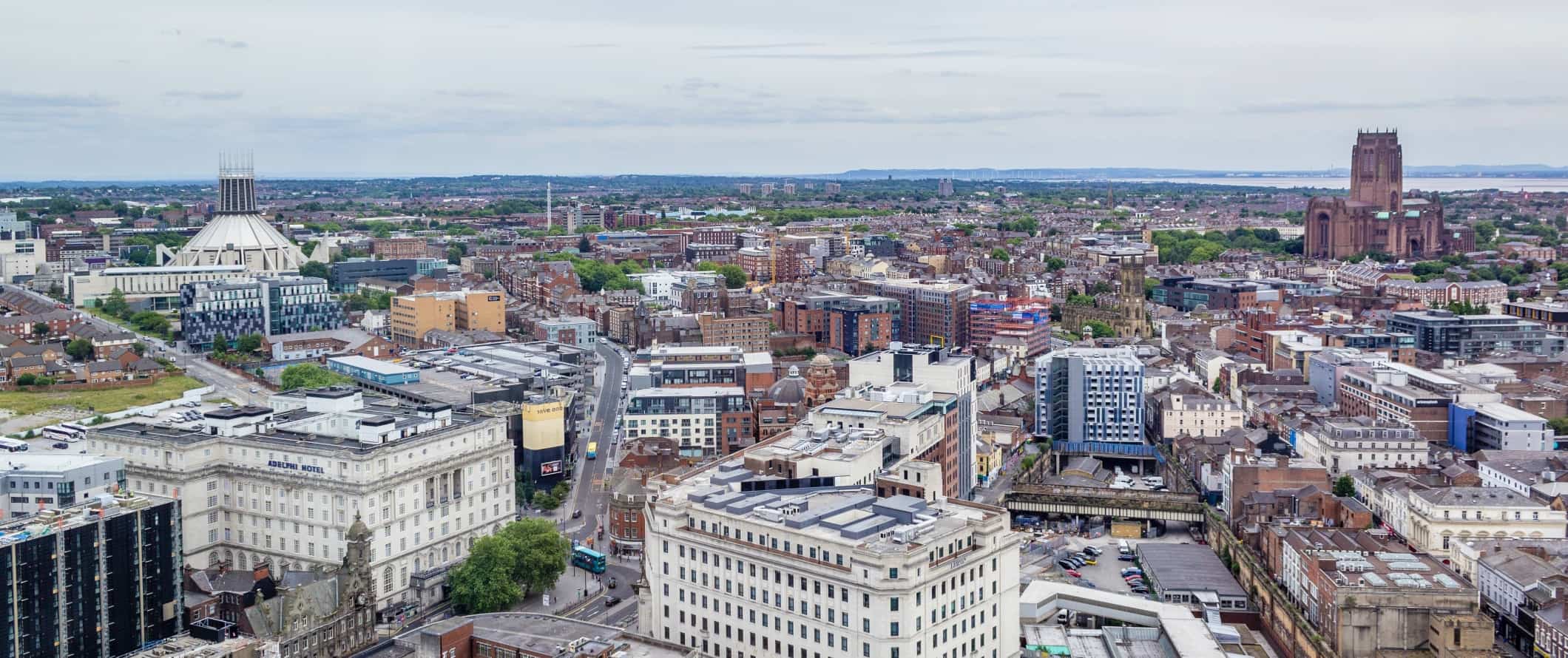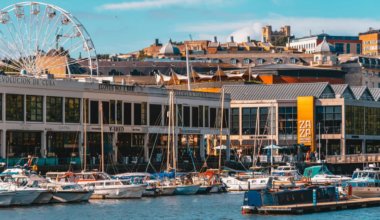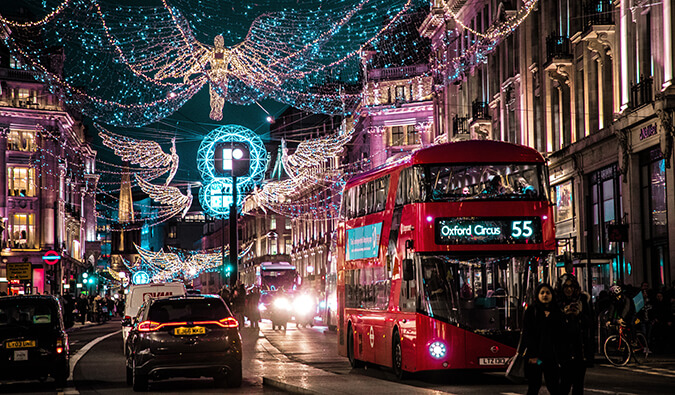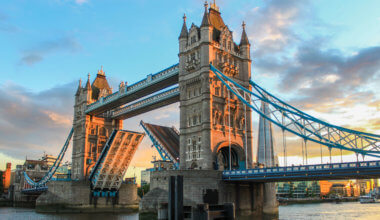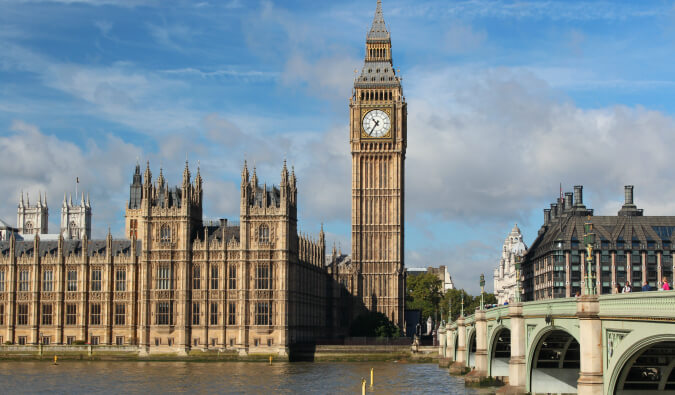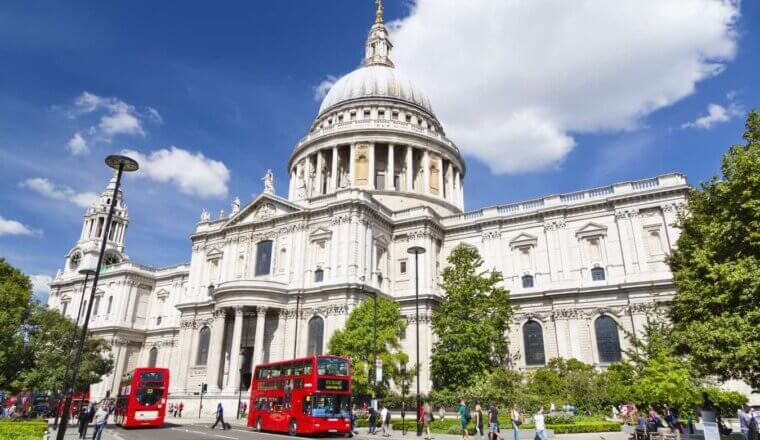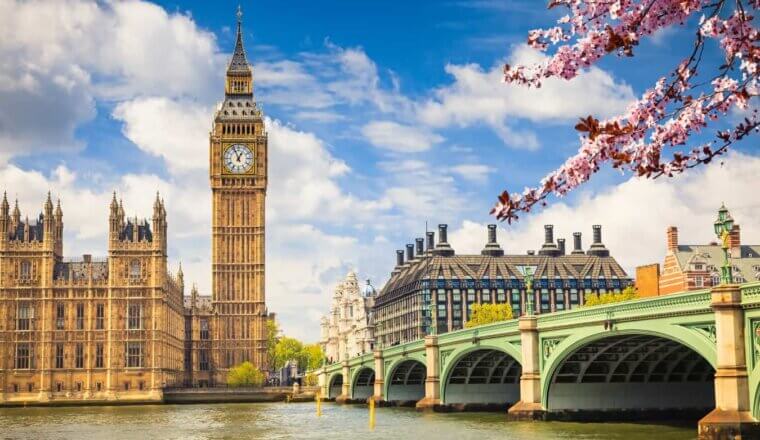Liverpool is one of the most visited cities in England. Like neighboring Manchester, Liverpool saw tremendous expansion during the Industrial Revolution, when it became a major port city.
After the city’s decline, Liverpool became known as a dingy industrial city that was filled with crime. It wasn’t a place most people wanted to go.
Fortunately, that reputation has been shaken off.
In the last few decades, the city has evolved into a major hub for food, art, and music. In fact, in 2008 Liverpool was named the European Capital of Culture.
There’s a lot to see when you visit Liverpool, including many free museums, parks, and inexpensive restaurants. As the World Capital City of Pop, the city is famous for its music scene. It’s best known as the birthplace of The Beatles, but the city is also home to the Royal Liverpool Philharmonic Orchestra, the oldest professional symphony orchestra in the UK.
This Liverpool travel guide can help you plan your trip so you save money and make the most of your time in this lively destination!
Table of Contents
Top 5 Things to See and Do in Liverpool
1. See the University of Liverpool
The university has beautiful, well-maintained grounds and gardens that make for a lovely afternoon stroll. Abercromby Square is a popular hangout, with a sprawling lawn and garden in the center. The university is one of the UK’s ‘red brick universities’ which is a name given to the civic universities built in major industrial cities throughout England in the 1900s. Liverpool University is often referred to as the Original Red Brick. The campus is only about a five-minute walk from Liverpool City Centre and spans around 100 acres. While you’re here, you can also visit the free Victoria Gallery & Museum, located in the university’s original red brick building.
2. Visit the World Museum
This free natural history museum contains a vast assortment of exhibits on world cultures, zoology, geology, and more. Once known as the Derby Museum, it opened in 1851 and included the 13th earl of Derby’s personal collection of natural history exhibits. The original two-room museum continued to grow in popularity, and it moved to a brand-new building in 1860. Heavily damaged during World War II, several exhibits were lost, and the museum didn’t reopen until 15 years after the end of the war. In 2005 there was a complete renovation which nearly doubled the size of the exhibits. Some of the best exhibits include the Natural History Centre, the planetarium, and one of the best Egyptian archaeology exhibitions in England (which includes several mummies).
3. Watch a football match
Football (soccer) is life here, and there’s no better way to see how the locals value the sport than to attend a match. You can see either Everton or Liverpool, but make sure to never root for the opposite team (the rivalry between Everton and Liverpool has been around since the late 1800s when the Liverpool Football Club was formed in response to a disagreement between the directors of Everton Football Club). Expect to pay around 40 GBP for tickets.
4. Learn about The Beatles
The award-winning Beatles Story museum is the world’s largest exhibition dedicated to the Beatles, telling the story of their rise to fame through memorabilia (including their instruments), imagery, and video. There are also replicas of iconic locations like Abbey Road Studios, Casbah, Mathew Street, and The Cavern where the band played many of their early Liverpool shows. Admission is 18 GBP.
5. Explore the Royal Albert Dock
Located in the historic waterfront area of Liverpool, the dock was originally designed by Jesse Hartley in 1846 and was used for ships carrying cotton, brandy, and sugar, along with other imports, all of which played an important role in the economy of the city. These days, the Royal Albert Dock is a complex of historic dock buildings and warehouses that contain several museums, such as the Merseyside Maritime Museum, the Tate Liverpool, and The Beatles Story. There are some awesome bars and restaurants here too and it’s the perfect place to check out Liverpool’s thriving arts and culture.
Other Things to See and Do in Liverpool
1. Take a free walking tour
One of the first things I do in a new city is to take a free walking tour. It’s the best way to see the main sights and connect with a local guide who can answer all your questions. New Europe offers daily free tours that last 3 hours and covers all the main sights (they have a paid tour just on The Beatles too). Just remember to tip your guide at the end!
2. Admire local art at the Bluecoat
Located in a historic 18th-century building (the oldest surviving building in Liverpool), The Bluecoat is a gallery and center for contemporary art. The venue also hosts special talks, events, dance, and visual arts exhibitions too. It’s free to visit, though tickets are required for some special events. Check the website for details to see what’s on during your visit.
3. Visit the International Slavery Museum
The International Slavery Museum (part of the free National Museums Liverpool network) focuses on slavery both past and present. Liverpool was a major slaving port during the 18th century, and the museum helps paint a vivid picture of how Liverpool grew in importance during this time — and at what cost. Exhibitions and artifacts from the Transatlantic slavery collection showcase the impact that slavery had not only on Liverpool but the entire world. Additional exhibitions include the African diaspora collection, the racist memorabilia collection, and an extensive section of the museum focused on contemporary slavery in today’s world. Admission is free.
4. Rock out at Liverpool International Music Festival
Every August, Liverpool puts on one of the biggest music festivals in the world. The festival was initially famous for being Europe’s largest free music event, but since 2018 it’s been a ticketed event (though prices are still reasonable and can be found for around 25 GBP). The performing artists are mostly DJs and producers, with a heavy focus on British artists. The weekend festival includes three outdoor stages and many creative artist spaces to chill out in the summer heat.
5. See Liverpool Cathedral
This 20th century Gothic Revival cathedral is the largest religious building in the United Kingdom. It’s also the longest cathedral in the world and listed on England’s National Heritage List. Huge, vaulted ceilings make up the central nave, choir, and central tower with impressive stained-glass windows throughout. On a clear day, the tower has breathtaking views of Liverpool, Merseyside, and beyond. It’s free to visit but the tower costs 6 GBP.
6. Get lost in the Williamson’s Tunnels
In the early 1800s, a Liverpool tobacco merchant, Joseph Williamson, funded the construction of an enormous labyrinth of tunnels around the city. To this day, nobody knows why. Friends of Williamson’s Tunnels offers free guided tours on Wednesdays and Sundays. You can also learn more at the Williamson Tunnels Heritage Centre, which gives guided tours (4.50 GBP) of a different tunnel section on Fridays, Saturdays, and Sundays.
7. Enjoy contemporary art at Tate Liverpool
Located in a warehouse at the Royal Albert Dock, Tate Liverpool’s opening in the 1980s helped to solidify Liverpool’s place in the contemporary art world, transforming the city from its rugged manufacturing past into a modern cosmopolitan city. Admission to Tate Liverpool is free (except for special exhibitions).
8. Learn about Liverpool’s maritime history
The Merseyside Maritime Museum details Liverpool’s seafaring past through artist renditions of maritime life, stories of life at sea, shipwrecked objects, ship models, and more. One of the museum’s highlights is an extensive collection on the Titanic (the Titanic’s home port was Liverpool). You can also book tickets here for the Old Dock Tour, where you’ll visit the world’s first commercial enclosed wet dock. Admission to the museum is free and the Old Dock Tour costs 8.50 GBP.
9. Visit the FACT Media Center
Foundation for Creative Art and Technology (FACT) is a leading organization dedicated to supporting British artists. There are two large art galleries here as well as three movie screens showing the latest art house releases (and occasionally mainstream releases). The complex also contains Picturehouse Bar (a cool bar where you can grab a drink) and a café. Entry to the exhibitions is free and cinema prices start at 8 GBP.
10. Relax at Sefton Park
One of Liverpool’s largest parks, here you’ll find plenty of walking paths, green space to enjoy a picnic, a large lake, and multiple cafes scattered throughout. Don’t miss the red Victorian bandstand, which is said to be the inspiration for The Beatles’ song, Sgt Pepper’s Lonely Hearts Club Band. The historic Sefton Park Palm House Conservatory showcases botanical life from around the world and hosts regular events for the public (admission is free).
11. Take a food tour
Liverpool has a vibrant food scene, and there’s no better way to spend your day than learning about the food culture of the city. Liverpool Tours has a tour that takes you to six different independent food and drink spots over the course of a three-hour tour. Tours are 80 GBP for individual tickets but booking two or more tickets brings the price down to 70 GBP each.
For more information on other cities in England, check out these guides!
Liverpool Travel Costs
Hostel prices – Dorms with 6-8 beds cost 30-50 GBP per night while a private room is 65-120 GBP, depending upon the season. Free Wi-Fi is standard, though most hostels here don’t have self-catering facilities or offer breakfast.
There are several campgrounds outside Liverpool for those who have a tent, but they are only convenient if you have a vehicle. Expect to pay at least 15 GBP for a basic plot without electricity.
Budget hotel prices – Budget hotels start at 50 GBP, with breakfast often included. Expect to pay at least 65 GBP during the peak summer season, especially when there are events or festivals happening.
There are lots of Airbnb options in Liverpool, with private rooms starting at 40 GBP per night while an entire home/apartment costs 70-90 GBP. Expect prices to double if you don’t book in advance.
Food – While British cuisine has evolved in leaps and bounds due to immigration (and colonialism), it’s still very much a meat and potatoes country. Fish and chips remain a popular staple for both lunch and dinner while roasted and stewed meats, sausages, meat pies, and the quintessential Yorkshire pudding are all common options as well. Curry (and other Indian dishes, such as tikka masala), are super popular too.
Fish and chips usually cost around 5 GBP and you can get a variety of cheap sandwiches for 5-7 GBP at local delis. Fast food (think McDonald’s) costs around 6 GBP for a combo meal.
For a mid-range meal at a pub or restaurant, expect to pay 10-17 GBP for a main course like burger, pasta, or a vegetarian meal. A pint of beer costs around 4 GBP and a latte/cappuccino is around 3 GBP.
You’ll find a fair amount of high-end dining in Liverpool. Expect to pay 40 GBP or more for a three-course menu. If you’re traveling on a budget, I’d skip the fancy food, as it’s pretty pricey!
Pizza starts at 9-10 GBP while Indian food is around 7-10 GBP for a main dish.
If you plan on cooking your own food, a week’s worth of groceries costs 40-60 GBP. This gets you basic staples like rice, pasta, produce, and some meat. The best places to buy cheap groceries are Lidl, Aldi, and Sainsbury’s.
Backpacking Liverpool Suggested Budgets
If you’re backpacking Liverpool, expect to spend about 65 GBP per day. This budget covers a hostel dorm, taking public transit, cooking your own meals, limiting your drinking, and doing mostly free activities like free walking tours and free museum visits. If you plan on drinking, add 10-15 GBP to your daily budget.
A mid-range budget of about 120 GBP per day covers staying in a private Airbnb room or private hostel room, eating out for most of your meals, taking the occasional taxi, having a few drinks, and doing some paid activities like taking a food tour or watching a soccer game.
On a “luxury” budget of about 250 GBP or more per day, you can stay in a hotel, eat out anywhere you want, drink as much as you want, rent a car or take more taxis, and do whatever activities you want. This is just the ground floor for luxury though. The sky is the limit!
Liverpool Travel Guide: Money-Saving Tips
Liverpool’s reputation as a student-friendly city makes it more affordable than most other English cities. With cheap pubs, plentiful public parks, and numerous free activities, there are a lot of ways to cut costs here. These are my top suggestions to save money in Liverpool:
- Enjoy the waterfront – Liverpool’s photographic waterfront of converted warehouses and docks is a great place to take in some seaside views and enjoy the historic architecture. There are lots of outdoor spots to sit and enjoy people watching for free.
- Take a free walking tour – If you want to get a sense of the city be sure to take a free walking tour. They last a couple of hours and are a great way to immerse yourself in the city while learning about its past. New Europe offers daily free tours of the city. Just be sure to tip your guide at the end.
- Spend an afternoon in the park – Stroll the walking trails and paths of Sefton Park, spending time at the lake and waterfalls. It’s a great spot to enjoy a budget-friendly afternoon.
- Visit the museums – All of the museums that are part of the National Museums Liverpool network are free. These top museums cover a range of topics including art, history, archaeology, and nautical themes. The Tate Liverpool is also free and worth wandering through.
- Stay with a local – If you’re on a budget, use Couchsurfing. It connects you with a local who can host you for free as part of a cultural exchange. They can share their insider tips about the city too!
- Bring a water bottle – The tap water here is safe to drink so bring a reusable water bottle to save money and reduce your plastic use. LifeStraw is my go-to brand as their bottles have built-in filters to ensure your water is always clean and safe.
Where to Stay in Liverpool
Liverpool only has a couple budget-friendly choices in the city. Here are my suggested places to stay:
How to Get Around Liverpool
Public transportation – Buses are the best way to get around Liverpool. A day pass costs 5 GBP for a single day and a three-day pass is 14.10 GBP. Single fares start at 2.20 GBP, making the day pass your best choice.
The city also has a rail system with 68 stations in and around Liverpool. Single-fare tickets cost 4.20GBP and a 7-day pass is 17.20 GBP.
Bicycle – Liverpool is a bike-friendly city. There are a variety of bike rental options throughout the city with bikes costing around 10-20 GBP for a rental.
Taxis – Taxis are readily available and cost 2.60 GBP to start and then 1.50 GBP per mile. Prices add up quickly so I wouldn’t take one unless absolutely necessary.
Ridesharing – Uber is available in Liverpool but public transport is the easiest and cheapest to get around in the city. Skip the rideshares if you can.
Car rental – Car rentals can be found for as little as 25 GBP per day for a multi-day rental, though you only need a car if you plan on leaving the city to explore the region. Just remember that you’ll be driving on the left and that most vehicles are manuals. Drivers need to be at least 21 years old.
For the best car rental prices, use Discover Cars.
When to Go to Liverpool
As a northern English city, Liverpool has a similar climate to nearby Manchester. Summer is the peak tourism season and offers warm weather, though it rarely gets above 21°C (70°F). The summer season is also festival season; expect the city to be more crowded during busy festival dates. Liverpool International Music Festival (August), Liverpool Pride (July), Africa Oyé (June), and Creamfields (August) are the biggest summer events. Expect higher accommodation prices during these events.
Spring (April-June) and autumn (September-October) are also fantastic times to visit, as temperatures are mild and the summer crowds have thinned. You may get some rain, but otherwise, it’s my favorite time to visit.
Winter sees temperatures just above freezing, sometimes reaching highs of 6-10°C (40-50°F). While the sun sets early during this time, the cold is not unbearable and the city is still bustling with activities. Around Christmas, the city is especially popular thanks to ice rinks, a festive Christmas Market, and lots of shopping.
How to Stay Safe in Liverpool
While violent crime against tourists is rare, Liverpool struggles with petty crime, though recently it has been recognized as a safer city than Manchester.
Scams and pickpocketing can occur around high traffic areas and on public transportation so be alert and keep your valuables secure and out of sight.
Pickpockets tend to work in teams, so stay alert and be aware of your surroundings. The Toxteth, Dingle, and Wavertree neighborhoods in south Liverpool are known to be seedier than other parts of Liverpool and Merseyside, but as a tourist, most of the attractions are in the central and north anyway.
Solo female travelers should generally feel safe here, however, the standard precautions apply (never leave your drink unattended at the bar, never walk home alone intoxicated, etc.).
Your biggest worry is likely to be walking around late at night, especially after leaving a pub or club after a few too many pints. Stay alert to avoid pickpockets and bad situations.
While scams here are rare, if you’re worried about getting ripped off you can read about common travel scams to avoid here.
if you experience an emergency, dial 999 for assistance.
The most important piece of advice I can offer is to purchase good travel insurance. Travel insurance will protect you against illness, injury, theft, and cancellations. It’s comprehensive protection in case anything goes wrong. I never go on a trip without it as I’ve had to use it many times in the past. You can use the widget below to find the policy right for you:
Liverpool Travel Guide: The Best Booking Resources
These are my favorite companies to use when I travel. They consistently have the best deals, offer world-class customer service and great value, and overall, are better than their competitors. They are the companies I use the most and are always the starting point in my search for travel deals.
- Skyscanner – Skyscanner is my favorite flight search engine. They search small websites and budget airlines that larger search sites tend to miss. They are hands down the number one place to start.
- Hostelworld – This is the best hostel accommodation site out there with the largest inventory, best search interface, and widest availability.
- Booking.com – The best all around booking site that constantly provides the cheapest and lowest rates. They have the widest selection of budget accommodation. In all my tests, they’ve always had the cheapest rates out of all the booking websites.
- HostelPass – This new card gives you up to 20% off hostels throughout Europe. It’s a great way to save money. They’re constantly adding new hostels too. I’ve always wanted something like this and glad it finallt exists.
- Get Your Guide – Get Your Guide is a huge online marketplace for tours and excursions. They have tons of tour options available in cities all around the world, including everything from cooking classes, walking tours, street art lessons, and more!
- The Man in Seat 61 – This website is the ultimate guide to train travel anywhere in the world. They have the most comprehensive information on routes, times, prices, and train conditions. If you are planning a long train journey or some epic train trip, consult this site.
- Trainline – When you’re ready to book your train tickets, use this site. It streamlines the process of booking trains around Europe.
- Rome2Rio – This website allows you to see how to get from point A to point B the best and cheapest way possible. It will give you all the bus, train, plane, or boat routes that can get you there as well as how much they cost.
- FlixBus – Flixbus has routes between 20 European countries with prices starting as low 5 EUR! Their buses include WiFi, electrical outlets, a free checked bag.
- SafetyWing – Safety Wing offers convenient and affordable plans tailored to digital nomads and long-term travelers. They have cheap monthly plans, great customer service, and an easy-to-use claims process that makes it perfect for those on the road.
- LifeStraw – My go-to company for reusable water bottles with built-in filters so you can ensure your drinking water is always clean and safe.
- Unbound Merino – They make lightweight, durable, easy-to-clean travel clothing.
- Top Travel Credit Cards – Points are the best way to cut down travel expenses. Here’s my favorite point earning credit cards so you can get free travel!
- BlaBlaCar – BlaBlaCar is a ridesharing website that lets you share rides with vetted local drivers by pitching in for gas. You simply request a seat, they approve, and off you go! It’s a cheaper and more interesting way to travel than by bus or train!
Liverpool Travel Guide: Related Articles
Want more info? Check out all the articles I’ve written on backpacking/traveling England and continue planning your trip:
